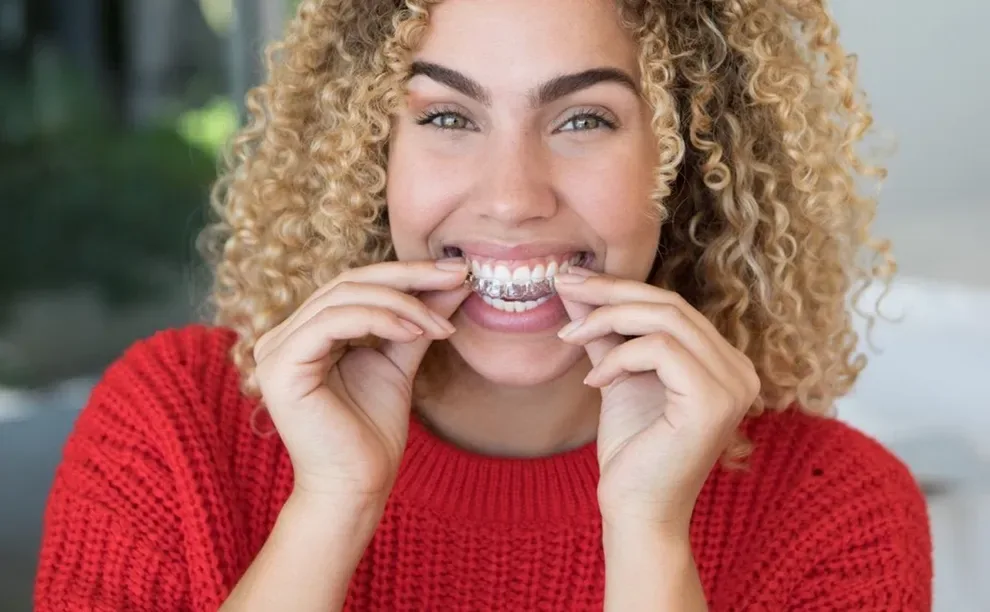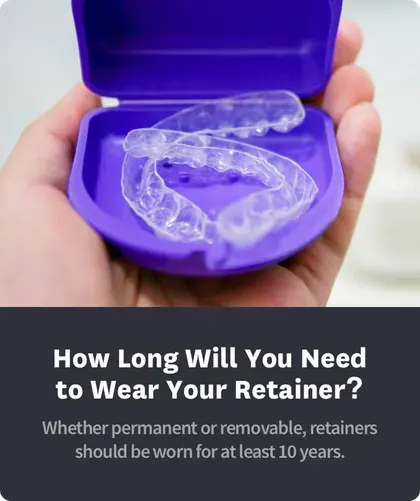How Long Do You Really Have to Wear a Retainer?

Table of Contents
- Permanent Retainers
- Wearing Retainers After Braces
- Is It for Life?
- How Many Hours per Day?
- How Many Days per Week?
- Proper Retainer Care
- Not Wearing It
- What Are Retainers?
- Understanding Your Retainer Schedule
- Frequently Asked Questions
Immediately after finishing your braces or aligner treatment plan, you’ll likely have to wear your retainer on a full-time basis for 24 hours a day. You’ll only take your retainer out to eat and brush and floss your teeth.
After 4 to 10 months, some people can transition to part-time retainer use, wearing the device only at night.
Because teeth shift naturally and may move due to other factors (especially if your smile was straightened as an adult), you may have to wear your retainer part-time indefinitely to protect your corrected bite and smile. If your orthodontic work happened during adolescence, you may be able to stop wearing the device after 10 years. Your dental professional can help you understand what program is right for you.
What Are Retainers?
Think of a retainer as protection. You've invested in your smile with braces or aligners. Your retainers ensure that your teeth stay in the right place.
Retainers keep your smile in place when active treatment is complete. Adults need to wear their retainers for life, but adolescents may be able to stop wearing them after about 10 years.
Multiple types of retainers exist, including these:
These are plates that sit on the roof of the mouth, and wires wrap around the front of the teeth to keep the plates in place. You can remove these retainers when you eat, or you may only wear them at night.
These retainers look a little like aligners. They wrap all the way around the teeth. Similarly, you remove them when you eat, or you might only wear them when you sleep.
These retainers sit behind the teeth, so they're not visible, but they never come out. You've probably heard of traditional and plastic retainers before. But permanent retainers might seem a little unusual to you.
This chart can help you understand the pros and cons of each type:
| What are they? | How long do they last? | Pros | Cons |
Removable wire retainers (Hawley retainers) | A combination of wire (to wrap around the teeth) and plastic (to cover the roof of the mouth) | Years | Can be removed to clean teeth, easy to repair if broken, cost-effective | Hard to adapt to, difficult to speak properly, breaks often |
Removable clear plastic retainers | Clear, plastic trays wrap around the teeth | Years | Easy to wear, thin and versatile, can be removed to clean teeth | Breaks easily, can’t be repaired, not suitable for all forms of treatment (like those involving expanded arches) |
Permanent retainers | A thin wire glued to the back of the teeth | Permanently | Invisible, impossible to remove (so you’ll wear it), easy to tolerate | Can lead to dental disease, bond can fail and allow teeth to move |
Retainers keep your smile in place when active treatment is complete and adults need to wear their retainers for life, but adolescents may be able to stop wearing them after about 10 years.
What is a Permanent Retainer, and How Long Is It Worn?
A permanent retainer is glued to the back of your teeth. Your orthodontist installs it, and it never comes out unless someone else removes it and dissolves the glue.
There’s no specified time for permanent retainer use, but you should check in annually with your orthodontist to ensure the retainer isn’t causing decay or bacteria buildup, and that it doesn’t need to be removed or cleaned. Experts say permanent retainers are typically recommended for people who had teeth that met these criteria:
Very rotated
Crowded
Spaced far apart
Teeth like this are very prone to take up their old positions, and they need the constant presence of a retainer to keep them in line and in place. A permanent retainer may also be recommended for people who struggle to follow instructions. You can't take it out, so you're not tempted to take a break from it. If you know you won't wear a removable retainer as instructed, a permanent version may be smart. But permanent retainers also come with some serious drawbacks, including risk of the following:
Damage: If the permanent retainer becomes broken, it can damage the tooth or gums.
Decay: Any fixed device can make it more difficult to clean your teeth, as plaque and bacteria can collect in the spaces between the wiring and the teeth and gums.
Discomfort: If there’s any friction between the retainer and tongue, chafing can be a problem.
Why You'll Be Wearing Retainers after Braces for a Long Time
Retainers aren’t just something you wear after you get your braces off. They’re part of your orthodontic treatment. Braces have moved your teeth into their ideal positions, and a retainer will keep them there (“retaining” your corrected smile and bite). If you don’t wear your retainer after completing your treatment, your teeth may move or shift back to their old position or to new incorrect positions. This can erase all of the work and time you’ve put into wearing and caring for your braces.
Do You Have to Wear Them for Life?
Whether you choose a permanent retainer or a removable version, that appliance will be part of your routine for at least 10 years, if not the rest of your life.
Braces and aligners work by applying consistent pressure that stretches the network of tissues that connect your teeth to your jaws. The bones in your teeth remodel and change shape based on that pressure. But some spring in the tissues remains.
The first few months are critical. When constant pressure is removed, teeth are tempted to take up their old positions. During this time, you'll wear your retainer all the time to protect your investment.
But even when that time passes, you'll need to keep your teeth in their new positions. It's best to wear your retainer at night, every night, to protect your teeth. If you had your dental work done when you were a teenager, and you wore your retainer for 10 years after treatment, you may be able to stop wearing the device if your dentist approves.
If you had your teeth adjusted as an adult, you'll wear your retainer for life. Your chances of teeth shifting are simply greater, and teeth tend to move as we age. To protect your investment, your retainer should be part of your life moving forward.

How Many Hours per Day Should You Wear a Retainer?
There’s no accepted protocol that works for everyone, researchers say. Instead, your dental professional will create a plan that’s based on preserving your oral health and perfect smile.
Most people are instructed to wear a retainer for 24 hours per day (unless eating and drinking) for 4 to 10 months. If your smile seems stable, you can shift to wearing your retainer at night only.
How Many Days Per Week Do You Need to Wear It?
You’ll need to wear your retainers every day. While missing a day or night here and there won’t cause dramatic issues, it’s important to make them part of your regular routine.
Understanding Your Retainer Schedule
Dental professionals consider aftercare a critical part of your treatment program. You should have a clear understanding of how and when to use your retainer when the acute portion of care ends. Your schedule might look like this.
Adults
Time frame | How many hours? | How many days? |
First 4-10 months | 24 | 7 |
11 months onward | 8 (nighttime only) | 7 |
Teenagers
Time frame | How many hours? | How many days? |
First 4-10 months | 24 | 7 |
11 months-10 years | 8 (nighttime only) | 7 |
10 years+ | 0 | 0 |
Take Care of your Removable Retainers
Because retainers are worn long term, they require regular maintenance and care.
Retainers you can pop in your mouth and remove again are easy to wear and clean. But they're also easy to neglect, and doing so could come with serious consequences.
While all retainers need care, how to do so varies by the type of retainer you have.
Traditional Retainers (Hawley)
Your Hawley retainer should be cleaned morning and night. You’ll need the following tools:
A soft-bristled toothbrush dedicated to your retainer care
Warm (not hot) water
Clean, unscented, undyed detergent
Rinse your retainer under warm water, and brush it with your soapy brush. When it’s clean, put it back in the case (unless you’re planning to wear it again right away).
Clear Plastic Retainers
Your clear plastic retainer trays should be washed morning and night. You’ll need the following tools:
A soft-bristled toothbrush dedicated to your retainer care
Warm (not hot) water
Clean, unscented, undyed detergent
Rinse your retainer under warm water, and brush it with your soapy brush. When it’s clean, put it back in the case (unless you’re planning to wear it again right away).
Permanent Retainers
When you’re brushing your teeth every morning and night, pay special attention to your retainer. Brush the metal of the retainer, and brush the tooth spaces above and below it. If you notice the retainer has come loose or shifted from its fixed position, tell your doctor right away.
What Happens if You Don’t Wear Your Retainer?
If you don’t wear your retainer, your teeth will eventually shift back to their old positions. This is particularly true in the months and even years directly following treatment with aligners or braces.
After you have consistently worn your retainers for at least 10 years, your teeth might be fixed in their new positions. But if they begin to shift again, you’ll need to return to regularly wearing your retainer.
Many people, particularly those who have braces or aligners in adulthood, need to wear their retainers for the rest of their lives.
Retainer Treatment Timeline Frequently Asked Questions
Your orthodontist will likely instruct you to wear your retainer full-time (only removing to eat and perform your daily hygiene routine) for 4 to 10 months immediately after braces treatment. To ensure your teeth stay in place, you may have to wear your retainer on a part-time basis for months, years, or even the rest of your life.
While many individuals will not need to wear a retainer on a full-time basis after six months, part-time retainer use will be needed to ensure teeth don’t shift or migrate over time.
How long you’ll have to wear your retainer after braces depends on your teeth and your treatment plan. Some people may only have to wear a retainer for a few years. Others may have to wear a retainer on a part-time basis indefinitely.
To ensure your teeth don’t have a chance to move back from their corrected positions, it’s important not to skip wearing your retainer. Skipping wearing your retainer once or twice isn’t likely to cause problems, but repeatedly not wearing the retainer as advised could allow for teeth to shift significantly.
